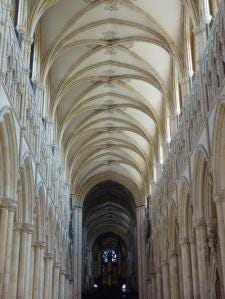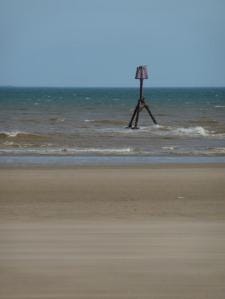Northern Rail Odyssey part 3: East and North Yorkshire
Having a rover ticket instead of the usual brace of singles at fixed times was remarkably liberating (more so than I'd expected). There was one journey where I planned a fixed itinerary because the services are infrequent and we had particular places we needed to get to, but on the final day we weren't even entirely sure where to go until we set off. It's wonderful to be able to admit after half an hour that you've run out of things to do in this town, or it's not to your taste, and march back up to the station just in time for a train to somewhere else. No putting a brave face on it, no tramping round getting colder and wetter as the clock ticks extra-slowly through the five hours to the train you're booked on. Timetables permitting, you can follow a hunch, visit one landmark you've always been curious about, or just see where the line goes. If you find yourself chugging through a post-industrial wasteland, you can always read a book (when did every station acquire a neighbouring Tesco? Seamer has a Morrisons instead, which at least serves as a landmark. Hull and Workington, and no doubt various other places I've forgotten, present industrial estates to the inbound traveller for a couple of minutes prior to the station, which is hardly an enticement to disembark).
Thanks to the sunshine we plumped for a circuitous route to the East coast. OneMonkey misses the coast, and while nowhere else is quite like the North Tyneside of his youth, sometimes any stretch of sea will suffice to reinvigorate his soul. Rather than the usual Leeds to Scarborough and change, we opted for Leeds to Hull. We almost (almost) walked out of Hull station into the city itself, but the old 'from Hell, Hull and Halifax may the Good Lord deliver us' trumped the more recent winning of the UK city of culture bid, and we settled for changing trains and heading to Beverley (sorry Hull, maybe someday. Probably in 2017).
Beverley, which neither of us had visited before, is tiny (like a compressed York) and yet has 2 branches of Caffe Nero, which I found shocking (having said that, Leeds city centre has at least 3 in a similar sized patch). It also, rather marvellously, has a WHSmith bookshop (separate from the general WHSmith further down the street) next to its Oxfam bookshop, as though the people of Beverley are insatiable book-buyers, and the usual-sized book sections of newsagents or charity shops simply can't cater for their needs.

Beverley Minster
Beverley Minster was a revelation, I can't believe we've never visited before (for a pair of unbelievers we spend a lot of our holidays visiting churches...) - light and airy, full of medieval carvings, and with the most welcoming bunch of guides (vicars? At least one was wearing a gown like an old-fashioned headmaster) who were happy to chat to us about the building and its history. Hexham Abbey (which was advertised here as another must-see destination on a church-lover's tour of Saxon Northumbria) faded from my memory instantly as I stepped outside, but Beverley Minster will stay with me for a while I think, just as Wells cathedral has for over ten years.

Carving in Beverley Minster
From Beverley we headed north-east to Bridlington, a first for OneMonkey who wanted to visit simply because we were passing and it's on the coast. I had it filed away in hazy childhood memories as a place of donkey rides and amusement arcades, in other words just another seaside town that probably looks a bit shabby on a Monday when the kids are still at school. It did look a bit shabby, and it smelt strongly of fish and seaweed, seemingly more so than any other coastal town I've visited. The strong breeze was blowing sand along the beach in interesting patterns, and there were clusters of gulls gathered here and there, but Bridlington was largely devoid of interest.

Bridlington
Filey was a good one to end on. Stuck firmly in some halcyon past that may not have existed outside this small North Yorkshire town, Filey should be prescribed to the stressed. It probably was, in the 1930s. It was surprisingly busy (more so than Brid), but the beach is big and flat enough for no-one to be within striking distance (and no-one's dog to be a nuisance). There were fossils, rock pools, dangerous-looking cliffs, gentler sand-eddies than at Brid (and next to no gulls), and the constant roar and shush of the sea. Tired and happy at tea-time (though still a few hours from tea) we stood in the shed that purports to be Filey station, and started planning the next bout of rail-roving.


